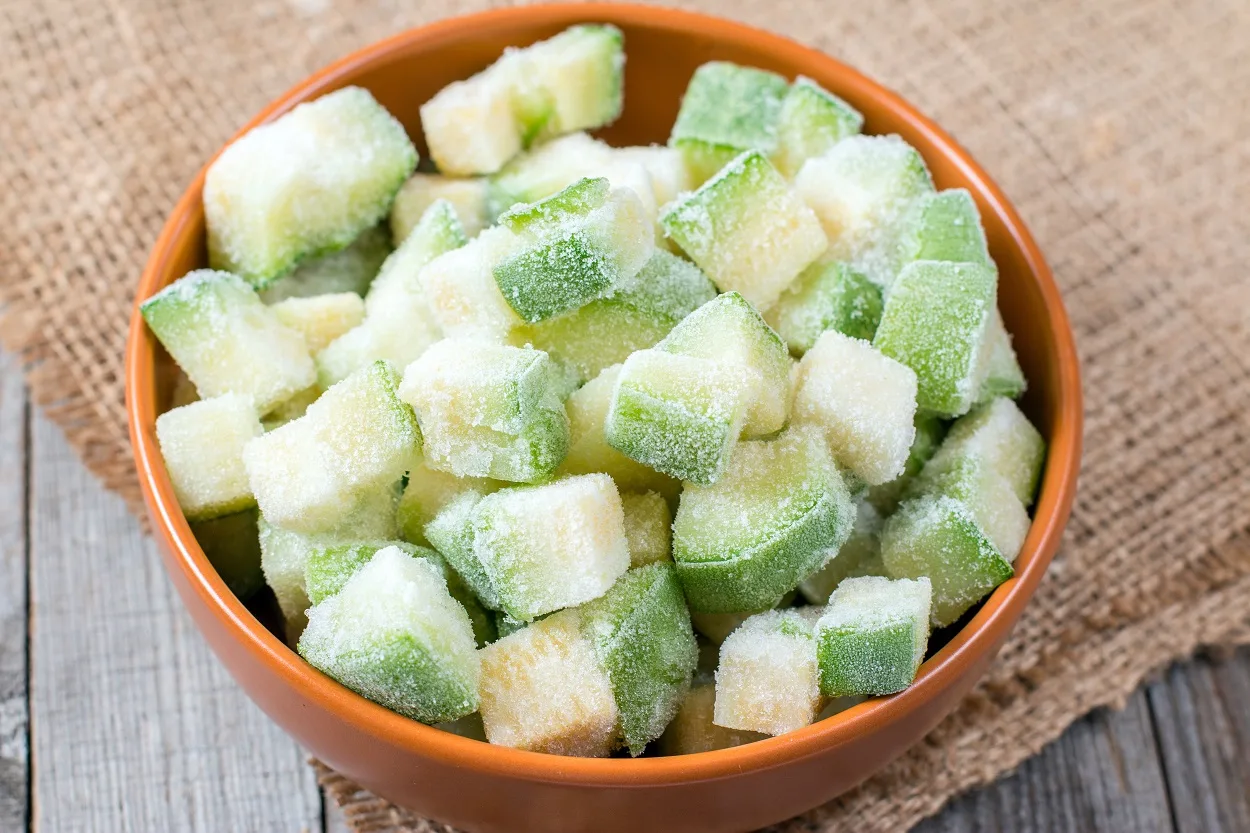Last Updated on 11th July 2023 by
Let me count the ways I love zucchini- I love it in zucchini bread, I love it grilled, and I love it in soup. It’s great as a kebab or as part of a stir fry, and I like to add it to salad as well to give the salad a bit of variety.
Zucchini is my favourite kind of squash, and I love how its flavour is differing tones of sweetness and bitterness. It doesn’t have a strong flavour, so it can be added to a lot of different foods without affecting their flavour very much. In that way zucchini is like a stock addition, similar to potatoes. It can help fill you up, supply you with some vitamins and then accept whatever flavours you add to the food.
I use zucchini in smoothies and casseroles, and it is a great addition to certain sauces, adding some thickness to them. You may want to use zucchini in spaghetti sauce, giving a chunky, veggie texture to the sauce. Because zucchini is a little sweet, you can use it in some desserts, like fruit cake or sweetbread.
Table of Contents
How to Cook Frozen Sliced Zucchini
Zucchini is mostly made of water- about 95%. What that means is that after you freeze it and then thaw it back out, it can get kind of soft. That makes it tricky to work with, so I understand why some people are wondering how to cook frozen zucchini. There is some challenge to it, and I want to make things as easy for you as I can.
Because of the wateriness of the zucchini, I find it is best to use the frozen and then thawed zucchini in soups, casseroles, sauces, and smoothies. Basically, anything that would be wet when you make it is perfect for zucchinis.
Since zucchinis don’t have a strong flavour to them, adding them to a dish is a good way to slip in some veggies without anyone being much wiser. They won’t affect the flavour much, but they can give you some extra vitamins in whatever you are eating.
If I am making smoothies or something else that is sweet and watery, I may use zucchini in place of some of the fruits. That cuts down on the sugar content, because even though zucchinis are a little sweet, they are not overly sweet like fruit would be.
What I would try to avoid doing is using the frozen zucchini in a a dish to itself. If you add them to a stir fry or to a salad after you thaw them, they will likely be too watery instead of crunchy like they are supposed to be.
You want to use your thawed zucchini in a way that takes advantage of its wateriness or hides the watery texture well, so be aware of that and look for recipes that do just that.
How to Cook Frozen Zucchini Noodles
Just like your zucchini slices, cooking frozen zucchini noodles can result in soggy noodles. How do you cook frozen squash and zucchini noodles without them becoming soggy and not very tasty?
The trick is to only cook them for a few minutes. Don’t try to cook them slowly over a long period of time and a low heat. You will help them retain the right texture if you cook them for just 3-5 minutes. That is all the time you need for them to cook properly. They will be a bit al dente, but that is fine, since they will continue to cook after the come off the heat. By the time you combine them with your food and dig in, they should be palatable. At least they won’t be soggy, so you have avoided that problem.
It’s best to eat your zucchini noodles as soon as they are done cooking. They can get soggy over time after they are cooked. Every moment they stay uneaten after cooking is important and you don’t want to waste a single moment you don’t have to.
How to Cook Frozen Breaded Zucchini
You get the same kind of problem with frozen breaded zucchini as you do with the plain zucchini. Once it thaws, it will be a bit soggy, and if you don’t cook it right, it will still be soggy when you eat it. Who wants to eat wet breading?
So, how to cook frozen zucchini and squash that is breaded and not soggy?
First of all, knock off the ice as much as possible. Ice will will stick to breaded foods pretty easily, and if you put that into hot oil, it can cause the oil to spatter and become dangerous. You don’t want that, of course. You also don’t need to let the breaded zucchini thaw. That is my secret of how to cook them without letting them get soggy.
Just preheat the oil while the zucchini stays in the freezer. Then, once the oil is hot, you can cook up the zucchini for about five minutes. That should be enough time to cook it thoroughly and make it the right texture.
If you let the zucchini thaw, it will become soggy. If you cook it for too long, it will get too dry, so five minutes is a good cooking time, using a medium heat on the pot of hot oil.
How to Freeze Zucchini
You should also know how to freeze your zucchini. I use a blanching method to help trap in the nutrients and the flavour. This means putting it into boiling hot water for just a few seconds and then transferring it to an ice bath. From there, pat it dry and store the zucchini in a plastic freezer storage bag.
It will stay fresh for months there. What this process does is stop enzymes from moving around and causing degradation in the squash. Essentially, it helps the decaying process to stop and keeps food fresh for longer, and I use blanching on most fruits and vegetables that I store in the freezer.
Keep in mind that taking zucchini out of the freezer to thaw is only necessary sometimes. It just depends on how you plan to cook it. Anytime you let it thaw, though, it will become soggy. That high water content is what does it, so be aware of that and cook and use zucchini appropriately.
If have covered frozen zucchini- how to cook and freeze it- and I hope this helps you out as you try to figure out what to do with your own zucchini. If you grow the plant yourself or just buy too much of it at once sometimes, now you have a way to store it long term and then to use it after it comes out of storage.
I hope this helps you the next time you have too much zucchini on hand and you aren’t sure if it will turn out okay if you place it in freezer storage. With the right preparation and cooking methods, you can deal with soggy zucchini and get the most out of the frozen veggie.
FAQs
Why does frozen zucchini often turn out soggy when cooked?
Zucchini contains a high amount of water, which freezes within the vegetable when it is frozen. Upon cooking, this water quickly turns to steam, creating a soggy texture. This is particularly pronounced if the zucchini is thawed before cooking, as this allows more water to escape.
What methods are recommended to prepare and cook frozen zucchini while maintaining its texture?
To prevent frozen zucchini from becoming soggy, it’s often best to cook it straight from the freezer without thawing, as this minimizes the amount of free water that can create a mushy texture. Techniques that can help maintain texture include sautéing on high heat quickly to evaporate some of the water or roasting in a hot oven to caramelize the sugars and drive off moisture. If using in a soup or stew, add the frozen zucchini towards the end of cooking to prevent it from breaking down too much.
Are there specific dishes or recipes where frozen zucchini works particularly well?
Frozen zucchini is particularly well-suited to dishes where a bit of softness won’t be a problem. This includes dishes like soups, stews, and sauces, as well as baked goods like zucchini bread or muffins. In these recipes, the moisture from the zucchini can actually be an advantage, adding to the moistness of the final dish.
I'm Pauline, a mother of four grown children, my passion for cooking stemmed from the joy i get cooking for my family. I love to try new dishes, especially when dining out but creating and sharing my own recipes is my favourite thing to do!



shough
Thursday 20th of February 2025
kxizr01CE0c
Terese
Wednesday 27th of July 2022
To let you know, I saw your low star rating for this article and clicked on the stars in order to read the reviews, thinking it's a clickable link like on Amazon. So i hit the strip of stars only to realize it immediately registered as an actual rating. So I unintentionally gave a 2 or 3 star rating and not able to remove it. I suspect others have done the same, so you might be getting a lot of low star reviews that you didn't deserve and people didn't intend to give. It would be smart to remove this feature altogether or to put direction above it as a warning.
Pauline Loughlin
Thursday 28th of July 2022
Thank you we will take a look at that